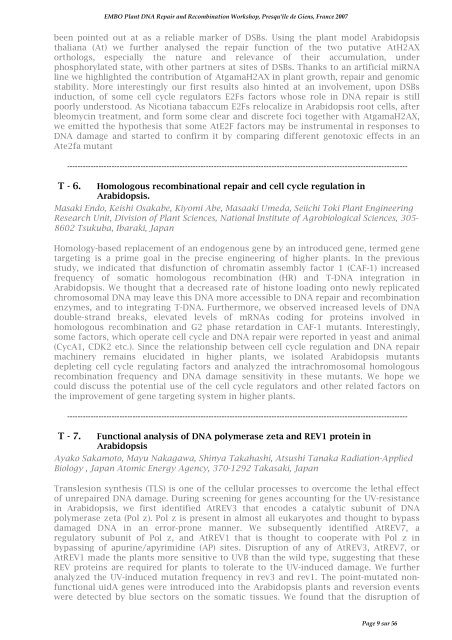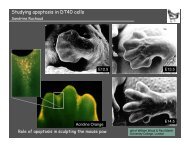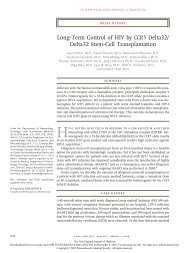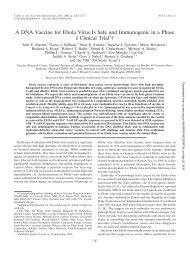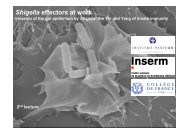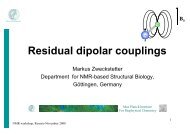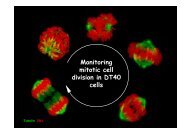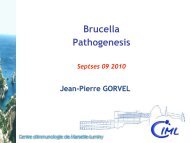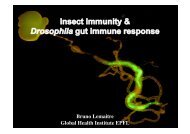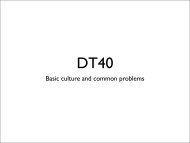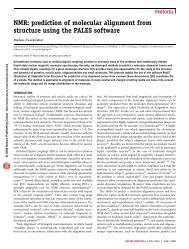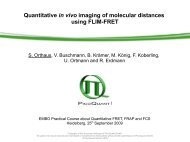pdf file - Events - EMBO
pdf file - Events - EMBO
pdf file - Events - EMBO
You also want an ePaper? Increase the reach of your titles
YUMPU automatically turns print PDFs into web optimized ePapers that Google loves.
<strong>EMBO</strong> Plant DNA Repair and Recombination Workshop, Presqu'île de Giens, France 2007<br />
been pointed out at as a reliable marker of DSBs. Using the plant model Arabidopsis<br />
thaliana (At) we further analysed the repair function of the two putative AtH2AX<br />
orthologs, especially the nature and relevance of their accumulation, under<br />
phosphorylated state, with other partners at sites of DSBs. Thanks to an artificial miRNA<br />
line we highlighted the contribution of AtgamaH2AX in plant growth, repair and genomic<br />
stability. More interestingly our first results also hinted at an involvement, upon DSBs<br />
induction, of some cell cycle regulators E2Fs factors whose role in DNA repair is still<br />
poorly understood. As Nicotiana tabaccum E2Fs relocalize in Arabidopsis root cells, after<br />
bleomycin treatment, and form some clear and discrete foci together with AtgamaH2AX,<br />
we emitted the hypothesis that some AtE2F factors may be instrumental in responses to<br />
DNA damage and started to confirm it by comparing different genotoxic effects in an<br />
Ate2fa mutant<br />
----------------------------------------------------------------------------------------------------------------------------------<br />
T - 6. Homologous recombinational repair and cell cycle regulation in<br />
Arabidopsis.<br />
Masaki Endo, Keishi Osakabe, Kiyomi Abe, Masaaki Umeda, Seiichi Toki Plant Engineering<br />
Research Unit, Division of Plant Sciences, National Institute of Agrobiological Sciences, 305-<br />
8602 Tsukuba, Ibaraki, Japan<br />
Homology-based replacement of an endogenous gene by an introduced gene, termed gene<br />
targeting is a prime goal in the precise engineering of higher plants. In the previous<br />
study, we indicated that disfunction of chromatin assembly factor 1 (CAF-1) increased<br />
frequency of somatic homologous recombination (HR) and T-DNA integration in<br />
Arabidopsis. We thought that a decreased rate of histone loading onto newly replicated<br />
chromosomal DNA may leave this DNA more accessible to DNA repair and recombination<br />
enzymes, and to integrating T-DNA. Furthermore, we observed increased levels of DNA<br />
double-strand breaks, elevated levels of mRNAs coding for proteins involved in<br />
homologous recombination and G2 phase retardation in CAF-1 mutants. Interestingly,<br />
some factors, which operate cell cycle and DNA repair were reported in yeast and animal<br />
(CycA1, CDK2 etc.). Since the relationship between cell cycle regulation and DNA repair<br />
machinery remains elucidated in higher plants, we isolated Arabidopsis mutants<br />
depleting cell cycle regulating factors and analyzed the intrachromosomal homologous<br />
recombination frequency and DNA damage sensitivity in these mutants. We hope we<br />
could discuss the potential use of the cell cycle regulators and other related factors on<br />
the improvement of gene targeting system in higher plants.<br />
----------------------------------------------------------------------------------------------------------------------------------<br />
T - 7. Functional analysis of DNA polymerase zeta and REV1 protein in<br />
Arabidopsis<br />
Ayako Sakamoto, Mayu Nakagawa, Shinya Takahashi, Atsushi Tanaka Radiation-Applied<br />
Biology , Japan Atomic Energy Agency, 370-1292 Takasaki, Japan<br />
Translesion synthesis (TLS) is one of the cellular processes to overcome the lethal effect<br />
of unrepaired DNA damage. During screening for genes accounting for the UV-resistance<br />
in Arabidopsis, we first identified AtREV3 that encodes a catalytic subunit of DNA<br />
polymerase zeta (Pol z). Pol z is present in almost all eukaryotes and thought to bypass<br />
damaged DNA in an error-prone manner. We subsequently identified AtREV7, a<br />
regulatory subunit of Pol z, and AtREV1 that is thought to cooperate with Pol z in<br />
bypassing of apurine/apyrimidine (AP) sites. Disruption of any of AtREV3, AtREV7, or<br />
AtREV1 made the plants more sensitive to UVB than the wild type, suggesting that these<br />
REV proteins are required for plants to tolerate to the UV-induced damage. We further<br />
analyzed the UV-induced mutation frequency in rev3 and rev1. The point-mutated nonfunctional<br />
uidA genes were introduced into the Arabidopsis plants and reversion events<br />
were detected by blue sectors on the somatic tissues. We found that the disruption of<br />
Page 9 sur 56


